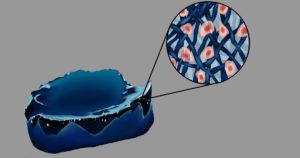NEWS
Caldorera-Moore awarded grant to continue work on innovative chronic-wound treatment
Dr. Mary Caldorera-Moore, an associate professor in Biomedical Engineering, is one of seven researchers to win a grant from the Southeast XLerator Network (XLN) to continue development on an innovative hydrogel biomaterial designed to aid in wound healing.

Illustration of proactive hydrogels for cell attachment and tissue regeneration. Illustration created by Marissa Nguyen, 2020 graduate with a BS in Biomedical Engineering and minor in Scientific Illustration (VISTA).
Hydrogels are “like Jell-O,” Caldorera-Moore said, and this particular project is focused on promoting cell regeneration for quicker healing in chronic wounds, injuries that do not heal in an orderly set of stages or in a predictable amount of time (more than three months). Some of the most common and costly chronic wounds are diabetic foot wounds, pressure wounds, and surgical infections.
“Between 1 and 2 percent of the total population are projected to experience a chronic wound during their lifetime in developed countries,” Caldorera-Moore said. “The prevalence of chronic wounds is growing for several reasons, including a sharp increase in the prevalence of obesity and the development of diabetes, an aging population, and a rapidly expanding need for wound care services for veterans.”
Chronic wounds can negatively impact a patient’s quality of life and mental health, Caldorera-Moore said, and they can contribute major costs to healthcare systems and societies. Often, lower-income patients suffer from chronic wounds in disproportionate numbers.
“Current treatment options tend to have a singular function: inhibit bleeding, reduce bacterial growth, or absorb large volumes of wound secretions,” Caldorera-Moore said. “Current treatment methods only address the wound symptoms instead of treating the underlying disturbances that prevent proper wound healing and tissue reorganization.”
Caldorera-Moore has been working in her lab with high school, undergraduate, and graduate students for about five years to develop the hydrogel from crustacean shells and gardenia extracts. The grant will serve as seed money for her to complete the last experiments necessary to be able to apply for a Small Business Innovation Research (SBIR) grant.
“The expectation is that eventually this will become a marketable product,” she said. “Chronic wounds are considered a silent epidemic right now. With diabetes, there is a 55-percent chance that you will have a chronic wound at some point. That was shocking to me. I thought, ‘We have intelligent biomaterials, surely we can do something that can help with these wounds that is also cost-effective.’”
Chronic wounds are one of the many complications of metabolic syndrome. In Louisiana, metabolic syndrome – increased blood pressure, high blood sugar, excess body fat around the waist, and abnormal cholesterol or triglyceride levels – are high. The demand for a product like Caldorera-Moore’s – one that is biocompatible and cost-effective – is high, especially here.
When completed, this project should result in wound-healing technology that is “affordable, easy to apply directly to a wound, and has a long shelf-life,” Caldorera-Moore said. “These characteristics make the wound dressing suitable as an over-the-counter bandage as well as for application by a medical professional in a clinical setting.”
The funding is part of the XLerator Network’s “Ideas to Products” (I2P) program that supports researchers with competitive proof-of-concept (POC) funding that will help accelerate healthcare technologies for commercialization across the Southeast IDeA States. I2P was developed to connect healthcare researchers with funds to support pilot projects that help assess the commercialization potential of their innovations coming from the laboratory.